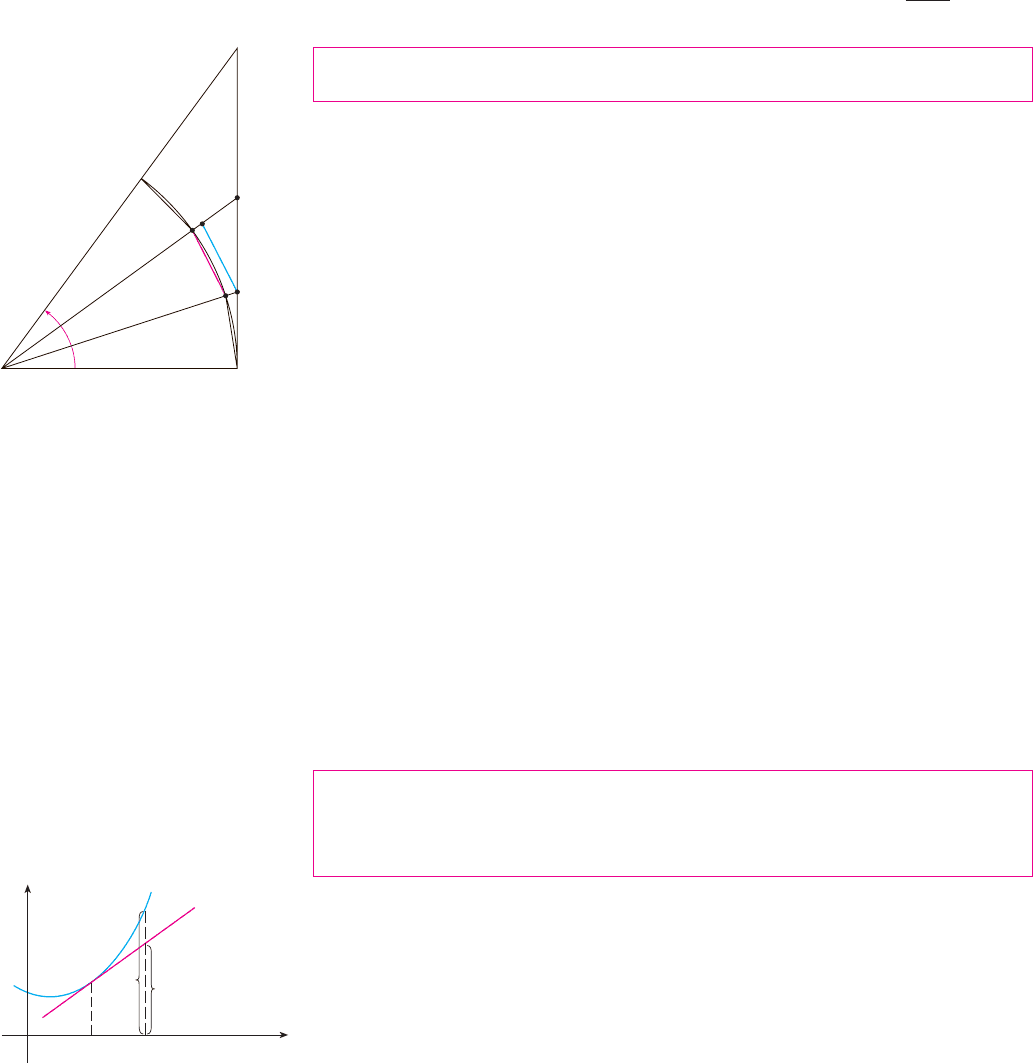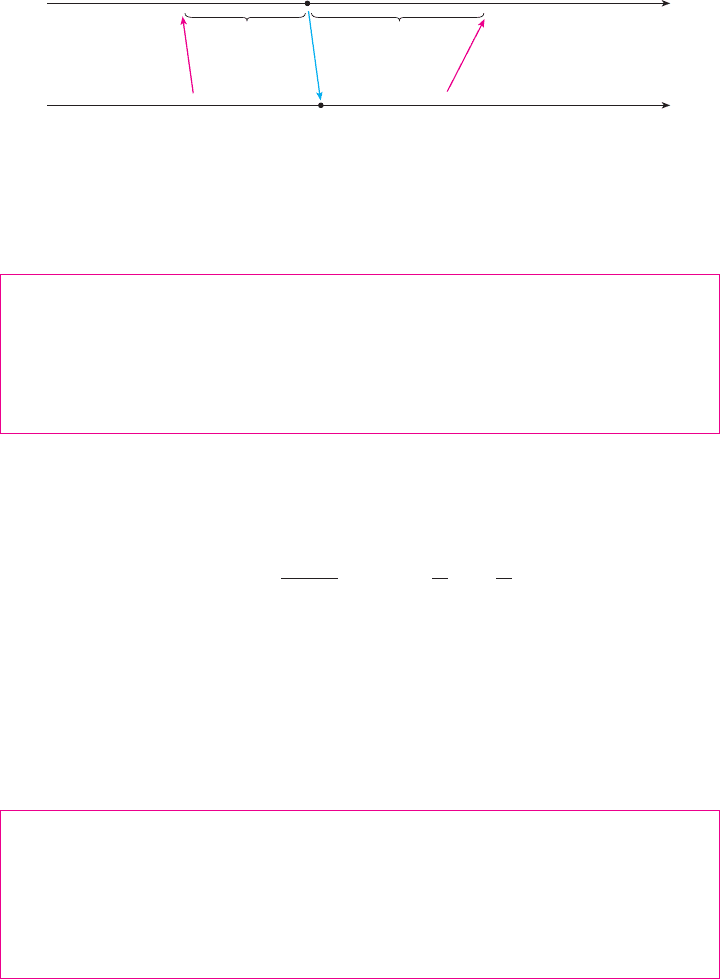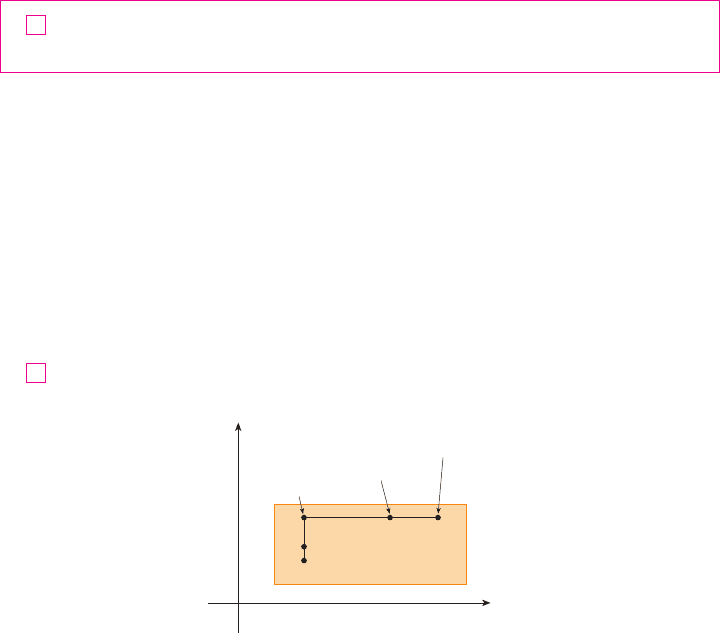Stewart J. Calculus
Подождите немного. Документ загружается.


A38
||||
APPENDIX E SIGMA NOTATION
35.
36. Find the number such that .
37. Prove formula (b) of Theorem 3.
38. Prove formula (e) of Theorem 3 using mathematical
induction.
39. Prove formula (e) of Theorem 3 using a method similar to that
of Example 5, Solution 1 [start with .
40. Prove formula (e) of Theorem 3 using the following method
published by Abu Bekr Mohammed ibn Alhusain Alkarchi in
about
AD 1010. The figure shows a square in which
sides and have been divided into segments of lengths ,
, ,..., Thus the side of the square has length
so the area is . But the area is also the sum of the
areas of the n “gnomons” , ,..., shown in the figure.
Show that the area of is and conclude that formula (e) is
true.
41. Evaluate each telescoping sum.
(a) (b)
(c) (d)
42. Prove the generalized triangle inequality:
43– 46 Find the limit.
43. 44.
45. lim
n l
兺
n
i苷1
2
n
冋冉
2i
n
冊
3
5
冉
2i
n
冊册
lim
n l
兺
n
i苷1
1
n
冋冉
i
n
冊
3
1
册
lim
n l
兺
n
i苷1
1
n
冉
i
n
冊
2
冟
兺
n
i苷1
a
i
冟
兺
n
i苷1
ⱍ
a
i
ⱍ
兺
n
i苷1
共a
i
a
i1
兲
兺
99
i苷3
冉
1
i
1
i 1
冊
兺
100
i苷1
共5
i
5
i1
兲
兺
n
i苷1
关i
4
共i 1兲
4
兴
12 3 4 5
...
nBA
1
2
3
4
5
n
D
.
.
.
C
G
n
G™
G£
G¢
G∞
.
.
.
i
3
G
i
G
n
G
2
G
1
关n共n 1兲兾2兴
2
n共n 1兲兾2n.32
1ADAB
ABCD
共1 i 兲
4
i
4
兴
兺
n
i苷1
i 苷 78n
兺
n
i苷1
共i
3
i 2兲
1–10 Write the sum in expanded form.
1. 2.
3. 4.
5. 6.
7. 8.
9. 10.
11– 20 Write the sum in sigma notation.
11.
12.
13.
14.
15.
16.
17.
18.
19.
20.
21–35 Find the value of the sum.
21. 22.
23. 24.
25. 26.
27. 28.
29. 30.
31. 32.
33. 34.
兺
n
i苷1
i共i 1兲共i 2兲
兺
n
i苷1
共i 1兲共i 2兲
兺
n
i苷1
共3 2i 兲
2
兺
n
i苷1
共i
2
3i 4兲
兺
n
i苷1
共2 5i 兲
兺
n
i苷1
2i
兺
4
i苷2
2
3i
兺
4
i苷0
共2
i
i
2
兲
兺
100
i苷1
4
兺
20
n苷1
共1兲
n
兺
8
k苷0
cos k
兺
6
j苷1
3
j1
兺
6
i苷3
i共i 2兲
兺
8
i苷4
共3i 2兲
1 x x
2
x
3
共1兲
n
x
n
x x
2
x
3
x
n
1
1
1
4
1
9
1
16
1
25
1
36
1 2 4 8 16 32
1 3 5 7 共2n 1兲
2 4 6 8 2n
3
7
4
8
5
9
6
10
23
27
1
2
2
3
3
4
4
5
19
20
s
3
s
4
s
5
s
6
s
7
1 2 3 4 10
兺
n
i苷1
f 共x
i
兲 x
i
兺
n1
j苷0
共1兲
j
兺
n3
j苷n
j
2
兺
n
i苷1
i
10
兺
8
k苷5
x
k
兺
4
k苷0
2k 1
2k 1
兺
6
i苷4
i
3
兺
6
i苷4
3
i
兺
6
i苷1
1
i 1
兺
5
i苷1
s
i
EXERCISES
E

APPENDIX F PROOFS OF THEOREMS
||||
A39
48. Evaluate .
49. Evaluate .
50. Evaluate .
兺
m
i苷1
冋
兺
n
j苷1
共i j 兲
册
兺
n
i苷1
共2i 2
i
兲
兺
n
i苷1
3
2
i1
46.
47. Prove the formula for the sum of a finite geometric series with
first term and common ratio :
兺
n
i苷1
ar
i1
苷 a ar ar
2
ar
n1
苷
a共r
n
1兲
r 1
r 苷 1a
lim
n
l
兺
n
i苷1
3
n
冋冉
1
3i
n
冊
3
2
冉
1
3i
n
冊册
PROOFS OF THEOREMS
In this appendix we present proofs of several theorems that are stated in the main body of
the text. The sections in which they occur are indicated in the margin.
SECTION 2.3 LIMIT LAWS Suppose that is a constant and the limits
and
exist. Then
1. 2.
3. 4.
5.
if
PROOF OF LAW 4 Let be given. We want to find such that
In order to get terms that contain and , we add and subtract
as follows:
(Triangle Inequality)
We want to make each of these terms less than .
Since , there is a number such that
Also, there is a number such that if , then
and therefore
ⱍ
t共x兲
ⱍ
苷
ⱍ
t共x兲 M M
ⱍ
ⱍ
t共x兲 M
ⱍ
ⱍ
M
ⱍ
1
ⱍ
M
ⱍ
ⱍ
t共x兲 M
ⱍ
1
0
ⱍ
x a
ⱍ
2
2
0
ⱍ
t共x兲 M
ⱍ
2
(
1
ⱍ
L
ⱍ
)
then0
ⱍ
x a
ⱍ
1
if
1
0lim
x l a
t共x兲 苷 M
兾2
苷
ⱍ
f 共x兲 L
ⱍⱍ
t共x兲
ⱍ
ⱍ
L
ⱍⱍ
t共x兲 M
ⱍ
ⱍ
关 f 共x兲 L兴t共x兲
ⱍ
ⱍ
L关t共x兲 M兴
ⱍ
苷
ⱍ
关 f 共x兲 L兴t共x兲 L关t共x兲 M 兴
ⱍ
ⱍ
f 共x兲t共x兲 LM
ⱍ
苷
ⱍ
f 共x兲t共x兲 Lt共x兲 Lt共x兲 LM
ⱍ
Lt共x兲
ⱍ
t共x兲 M
ⱍⱍ
f 共x兲 L
ⱍ
ⱍ
f 共x兲t共x兲 LM
ⱍ
then0
ⱍ
x a
ⱍ
if
00
M 苷 0lim
x l a
f 共x兲
t共x兲
苷
L
M
lim
x
l
a
关 f 共x兲t共x兲兴 苷 LMlim
x l a
关cf共x兲兴 苷 cL
lim
x l a
关 f 共x兲 t共x兲兴 苷 L Mlim
x l a
关 f 共x兲 t共x兲兴 苷 L M
lim
x l a
t共x兲 苷 Mlim
x l a
f 共x兲 苷 L
c
F

Since , there is a number such that
Let min . If , then we have ,
, and , so we can combine the inequalities to obtain
This shows that . M
PROOF OF LAW 3 If we take in Law 4, we get
(by Law 7) M
PROOF OF LAW 2 Using Law 1 and Law 3 with , we have
M
PROOF OF LAW 5 First let us show that
To do this we must show that, given , there exists such that
Observe that
We know that we can make the numerator small. But we also need to know that the
denominator is not small when is near . Since , there is a number
such that, whenever , we have
and therefore
ⱍ
M
ⱍ
2
ⱍ
t共x兲
ⱍ
ⱍ
M
ⱍ
苷
ⱍ
M t共x兲 t共x兲
ⱍ
ⱍ
M t共x兲
ⱍ
ⱍ
t共x兲
ⱍ
ⱍ
t共x兲 M
ⱍ
ⱍ
M
ⱍ
2
0
ⱍ
x a
ⱍ
1
1
0
lim
x l a
t共x兲 苷 Max
冟
1
t共x兲
1
M
冟
苷
ⱍ
M t共x兲
ⱍ
ⱍ
Mt共x兲
ⱍ
冟
1
t共x兲
1
M
冟
then0
ⱍ
x a
ⱍ
if
00
lim
x l a
1
t共x兲
苷
1
M
苷 lim
x l a
f 共x兲 共1兲 lim
x l a
t共x兲 苷 lim
x l a
f 共x兲 lim
x l a
t共x兲
lim
x
l
a
关 f 共x兲 t共x兲兴 苷 lim
x
l
a
关 f 共x兲 共1兲t共x兲兴 苷 lim
x
l
a
f 共x兲 lim
x
l
a
共1兲t共x兲
c 苷 1
苷 c lim
x l a
f 共x兲
苷 lim
x l a
c ⴢ lim
x l a
f 共x兲
lim
x l a
关cf共x兲兴 苷 lim
x l a
关t共x兲f 共x兲兴 苷 lim
x l a
t共x兲 ⴢ lim
x l a
f 共x兲
t共x兲 苷 c
lim
x l a
f 共x兲t共x兲 苷 LM
2
2
苷
2
(
1
ⱍ
M
ⱍ
)
(
1
ⱍ
M
ⱍ
)
ⱍ
L
ⱍ
2
(
1
ⱍ
L
ⱍ
)
ⱍ
f 共x兲t共x兲 LM
ⱍ
ⱍ
f 共x兲 L
ⱍⱍ
t共x兲
ⱍ
ⱍ
L
ⱍⱍ
t共x兲 M
ⱍ
0
ⱍ
x a
ⱍ
3
0
ⱍ
x a
ⱍ
2
0
ⱍ
x a
ⱍ
1
0
ⱍ
x a
ⱍ
兵
1
,
2
,
3
其
苷
ⱍ
f 共x兲 L
ⱍ
2
(
1
ⱍ
M
ⱍ
)
then0
ⱍ
x a
ⱍ
3
if
3
0lim
x l a
f 共x兲 苷 L
A40
||||
APPENDIX F PROOFS OF THEOREMS

This shows that
and so, for these values of ,
Also, there exists such that
Let min . Then, for , we have
It follows that . Finally, using Law 4, we obtain
M
THEOREM If for all in an open interval that contains (except
possibly at ) and
and
then .
PROOF We use the method of proof by contradiction. Suppose, if possible, that .
Law 2 of limits says that
Therefore, for any , there exists such that
In particular, taking (noting that by hypothesis), we have a
number such that
then
Since for any number , we have
then
which simplifies to
then
But this contradicts . Thus the inequality must be false. Therefore
. M
L M
L Mf 共x兲 t共x兲
t共x兲
f 共x兲0
ⱍ
x a
ⱍ
if
关t共x兲 f 共x兲兴 共M L兲
L M0
ⱍ
x a
ⱍ
if
aa
ⱍ
a
ⱍ
ⱍ
关t共x兲 f 共x兲兴 共M L兲
ⱍ
L M0
ⱍ
x a
ⱍ
if
0
L M 0 苷 L M
ⱍ
关t共x兲 f 共x兲兴 共M L兲
ⱍ
then0
ⱍ
x a
ⱍ
if
00
lim
x l a
关t共x兲 f 共x兲兴 苷 M L
L M
L M
lim
x l a
t共x兲 苷 Mlim
x l a
f 共x兲 苷 L
a
axf 共x兲 t共x兲
2
苷 lim
x
l
a
f 共x兲 lim
x
l
a
1
t共x兲
苷 L ⴢ
1
M
苷
L
M
lim
x
l
a
f 共x兲
t共x兲
苷 lim
x
l
a
f 共x兲
冉
1
t共x兲
冊
lim
x l a
1兾t共x兲 苷 1兾M
冟
1
t共x兲
1
M
冟
苷
ⱍ
M t共x兲
ⱍ
ⱍ
Mt共x兲
ⱍ
2
M
2
M
2
2
苷
0
ⱍ
x a
ⱍ
兵
1
,
2
其
苷
ⱍ
t共x兲 M
ⱍ
M
2
2
then0
ⱍ
x a
ⱍ
2
if
2
0
1
ⱍ
Mt共x兲
ⱍ
苷
1
ⱍ
M
ⱍⱍ
t共x兲
ⱍ
1
ⱍ
M
ⱍ
ⴢ
2
ⱍ
M
ⱍ
苷
2
M
2
x
ⱍ
t共x兲
ⱍ
ⱍ
M
ⱍ
2
then0
ⱍ
x a
ⱍ
1
if
APPENDIX F PROOFS OF THEOREMS
||||
A41

THE SQUEEZE THEOREM If for all in an open interval that
contains (except possibly at ) and
then
PROOF Let be given. Since , there is a number such that
if then
that is,
if then
Since , there is a number such that
then
that is,
then
Let min . If , then and ,
so
In particular,
and so . Therefore . M
SECTION 2.5 THEOREM If is continuous at and , then
PROOF Let be given. We want to find a number such that
if
Since is continuous at , we have
and so there exists such that
if
Since , there exists such that
if
ⱍ
t共x兲 ⫺ b
ⱍ
⬍
␦
1
then0
⬍
ⱍ
x ⫺ a
ⱍ
⬍
␦
␦
⬎ 0lim
x l a
t共x兲 苷 b
ⱍ
f 共y兲 ⫺ f 共b兲
ⱍ
⬍
then0
⬍
ⱍ
y ⫺ b
ⱍ
⬍
␦
1
␦
1
⬎ 0
lim
y l b
f 共y兲 苷 f 共b兲
bf
ⱍ
f 共t共x兲兲 ⫺ f 共b兲
ⱍ
⬍
then0
⬍
ⱍ
x ⫺ a
ⱍ
⬍
␦
␦
⬎ 0⬎0
lim
x l a
f 共t共x兲兲 苷 f 共b兲
lim
x l a
t共x兲 苷 bbf
8
lim
x l a
t共x兲 苷 L
ⱍ
t共x兲 ⫺ L
ⱍ
⬍
L ⫺
⬍
t共x兲
⬍
L ⫹
L ⫺
⬍
f 共x兲 艋 t共x兲 艋 h共x兲
⬍
L ⫹
0
⬍
ⱍ
x ⫺ a
ⱍ
⬍
␦
2
0
⬍
ⱍ
x ⫺ a
ⱍ
⬍
␦
1
0
⬍
ⱍ
x ⫺ a
ⱍ
⬍
␦
兵
␦
1
,
␦
2
其
␦
苷
L ⫺
⬍
h共x兲
⬍
L ⫹0
⬍
ⱍ
x ⫺ a
ⱍ
⬍
␦
2
if
ⱍ
h共x兲 ⫺ L
ⱍ
⬍
0
⬍
ⱍ
x ⫺ a
ⱍ
⬍
␦
2
if
␦
2
⬎ 0lim
x l a
h共x兲 苷 L
L ⫺
⬍
f 共x兲
⬍
L ⫹0
⬍
ⱍ
x ⫺ a
ⱍ
⬍
␦
1
ⱍ
f 共x兲 ⫺ L
ⱍ
⬍
0
⬍
ⱍ
x ⫺ a
ⱍ
⬍
␦
1
␦
1
⬎ 0lim
x l a
f 共x兲 苷 L⬎0
lim
x l a
t共x兲 苷 L
lim
x l a
f 共x兲 苷 lim
x l a
h共x兲 苷 L
aa
xf 共x兲 艋 t共x兲 艋 h共x兲
3
A42
||||
APPENDIX F PROOFS OF THEOREMS

Combining these two statements, we see that whenever we have
, which implies that . Therefore we have proved
that . M
SECTION 3.4 The proof of the following result was promised when we proved that
.
THEOREM If , then .
PROOF Figure 1 shows a sector of a circle with center , central angle , and radius 1.
Then
We approximate the arc by an inscribed polygon consisting of equal line segments
and we look at a typical segment . We extend the lines and to meet in the
points and . Then we draw as in Figure 1. Observe that
and so . Therefore we have
If we add such inequalities, we get
where is the length of the inscribed polygon. Thus, by Theorem 2.3.2, we have
But the arc length is defined in Equation 9.1.1 as the limit of the lengths of inscribed
polygons, so
M
SECTION 4.3 CONCAVITY TEST
(a) If for all in , then the graph of is concave upward on .
(b) If for all in , then the graph of is concave downward on .
PROOF OF (a) Let be any number in . We must show that the curve lies above
the tangent line at the point . The equation of this tangent is
So we must show that
whenever . (See Figure 2.)共x 苷 a兲x 僆 I
f 共x兲 ⬎ f 共a兲 ⫹ f ⬘共a兲共x ⫺ a兲
y 苷 f 共a兲 ⫹ f ⬘共a兲共x ⫺ a兲
共a, f 共a兲兲
y 苷 f 共x兲Ia
IfIxf ⬙共x兲
⬍
0
IfIxf ⬙共x兲 ⬎ 0
苷 lim
n
l
⬁
L
n
艋 tan
lim
n
l
⬁
L
n
艋 tan
L
n
L
n
⬍
ⱍ
AD
ⱍ
苷 tan
n
ⱍ
PQ
ⱍ
⬍
ⱍ
RT
ⱍ
⬍
ⱍ
RS
ⱍ
⬔RTS ⬎ 90⬚
⬔RTO 苷 ⬔PQO
⬍
90⬚
RT 储 PQSR
ADOQOPPQ
nAB
ⱍ
AD
ⱍ
苷
ⱍ
OA
ⱍ
tan
苷 tan
O
艋 tan
0
⬍
⬍
兾2
lim
l 0
sin
苷 1
lim
x l a
f 共t共x兲兲 苷 f 共b兲
ⱍ
f 共t共x兲兲 ⫺ f 共b兲
ⱍ
⬍
ⱍ
t共x兲 ⫺ b
ⱍ
⬍
␦
1
0
⬍
ⱍ
x ⫺ a
ⱍ
⬍
␦
APPENDIX F PROOFS OF THEOREMS
||||
A43
Q
T
S
°
°
B
D
°
°
P
R
AO1
FIGURE 1
¨
FIGURE 2
ax
f(a)+fª(a)(x-a)
ƒ
y=ƒ
x
y
0

First let us take the case where . Applying the Mean Value Theorem to on the
interval , we get a number , with , such that
Since on , we know from the Increasing/Decreasing Test that is increasing
on . Thus, since , we have
and so, multiplying this inequality by the positive number , we get
Now we add to both sides of this inequality:
But from Equation 1 we have . So this inequality becomes
which is what we wanted to prove.
For the case where we have , but multiplication by the negative
number reverses the inequality, so we get (2) and (3) as before.
M
SECTION 7.1 THEOREM If is a one-to-one continuous function defined on an interval
, then its inverse function is also continuous.
PROOF First we show that if is both one-to-one and continuous on , then it must
be either increasing or decreasing on . If it were neither increasing nor decreasing,
then there would exist numbers , , and in with such that
does not lie between and . There are two possibilities: either (1) lies
between and or (2) lies between and . (Draw a picture.) In
case (1) we apply the Intermediate Value Theorem to the continuous function to get a
number between and such that . In case (2) the Intermediate Value
Theorem gives a number between and such that . In either case we
have contradicted the fact that is one-to-one.
Let us assume, for the sake of definiteness, that is increasing on . We take any
number in the domain of and we let ; that is, is the number in
such that . To show that is continuous at we take any such
that the interval is contained in the interval . Since is increasing,
it maps the numbers in the interval onto the numbers in the interval
and reverses the correspondence. If we let denote the
smaller of the numbers and , then the interval
is contained in the interval and so is mapped
into the interval by . (See the arrow diagram in Figure 3.) We have
therefore found a number such that
ⱍ
f
⫺1
共y兲 ⫺ f
⫺1
共y
0
兲
ⱍ
⬍
then
ⱍ
y ⫺ y
0
ⱍ
⬍
␦
if
␦
⬎ 0
f
⫺1
共x
0
⫺, x
0
⫹兲
共 f 共x
0
⫺兲, f 共x
0
⫹兲兲共y
0
⫺
␦
, y
0
⫹
␦
兲
␦
2
苷 f 共x
0
⫹兲 ⫺ y
0
␦
1
苷 y
0
⫺ f 共x
0
⫺兲
␦
f
⫺1
共 f 共x
0
⫺兲, f 共x
0
⫹兲兲
共x
0
⫺, x
0
⫹兲
f共a, b兲共x
0
⫺, x
0
⫹兲
⬎0y
0
f
⫺1
f 共x
0
兲 苷 y
0
共a, b兲
x
0
f
⫺1
共y
0
兲 苷 x
0
f
⫺1
y
0
共a, b兲f
f
f 共c兲 苷 f 共x
1
兲x
3
x
2
c
f 共c兲 苷 f 共x
3
兲x
2
x
1
c
f
f 共x
3
兲f 共x
2
兲f 共x
1
兲f 共x
2
兲f 共x
1
兲
f 共x
3
兲f 共x
3
兲f 共x
1
兲
f 共x
2
兲x
1
⬍
x
2
⬍
x
3
共a, b兲x
3
x
2
x
1
共a, b兲
共a, b兲f
f
⫺1
共a, b兲
f
6
x ⫺ a
f ⬘共c兲
⬍
f ⬘共a兲x
⬍
a
f 共x兲 ⬎ f 共a兲 ⫹ f ⬘共a兲共x ⫺ a兲
3
f 共x兲 苷 f 共a兲 ⫹ f ⬘共c兲共x ⫺ a兲
f 共a兲 ⫹ f ⬘共a兲共x ⫺ a兲
⬍
f 共a兲 ⫹ f ⬘共c兲共x ⫺ a兲
f 共a兲
f ⬘共a兲共x ⫺ a兲
⬍
f ⬘共c兲共x ⫺ a兲
2
x ⫺ a
f ⬘共a兲
⬍
f ⬘共c兲
a
⬍
cI
f ⬘If ⬙⬎0
f 共x兲 ⫺ f 共a兲 苷 f ⬘共c兲共x ⫺ a兲
1
a
⬍
c
⬍
xc关a, x兴
fx ⬎ a
A44
||||
APPENDIX F PROOFS OF THEOREMS

This shows that and so is continuous at any number in
its domain. M
SECTION 12.8 In order to prove Theorem 12.8.3, we first need the following results.
THEOREM
1.
If a power series converges when (where ), then it converges
whenever .
2. If a power series diverges when (where ), then it diverges
whenever .
PROOF OF 1 Suppose that converges. Then, by Theorem 12.2.6, we have
. According to Definition 12.1.2 with , there is a positive integer
such that whenever . Thus, for , we have
If , then , so is a convergent geometric series. Therefore,
by the Comparison Test, the series is convergent. Thus the series is
absolutely convergent and therefore convergent. M
PROOF OF 2 Suppose that diverges. If is any number such that , then
cannot converge because, by part 1, the convergence of would imply the
convergence of . Therefore diverges whenever . M
THEOREM For a power series there are only three possibilities:
1. The series converges only when .
2. The series converges for all .
3. There is a positive number such that the series converges if and
diverges if .
PROOF Suppose that neither case 1 nor case 2 is true. Then there are nonzero numbers
and such that converges for and diverges for . Therefore the set
is not empty. By the preceding theorem, the series diverges if
, so for all . This says that is an upper bound for the set .
Thus, by the Completeness Axiom (see Section 12.1), has a least upper bound . If
, then , so diverges. If , then is not an upper bound for
and so there exists such that . Since , converges, so by the
preceding theorem converges. M
冘
c
n
x
n
冘
c
n
b
n
b 僆 Sb ⬎
ⱍ
x
ⱍ
b 僆 SS
ⱍ
x
ⱍⱍ
x
ⱍ
⬍
R
冘
c
n
x
n
x 僆 S
ⱍ
x
ⱍ
⬎ R
RS
S
ⱍ
d
ⱍ
x 僆 S
ⱍ
x
ⱍ
艋
ⱍ
d
ⱍⱍ
x
ⱍ
⬎
ⱍ
d
ⱍ
S 苷 兵x
ⱍ
冘
c
n
x
n
converges其
x 苷 dx 苷 b
冘
c
n
x
n
d
b
ⱍ
x
ⱍ
⬎ R
ⱍ
x
ⱍ
⬍
RR
x
x 苷 0
冘
c
n
x
n
ⱍ
x
ⱍ
⬎
ⱍ
d
ⱍ
冘
c
n
x
n
冘
c
n
d
n
冘
c
n
x
n
冘
c
n
x
n
ⱍ
x
ⱍ
⬎
ⱍ
d
ⱍ
x
冘
c
n
d
n
冘
c
n
x
n
冘
⬁
n苷N
ⱍ
c
n
x
n
ⱍ
冘
ⱍ
x兾b
ⱍ
n
ⱍ
x兾b
ⱍ
⬍
1
ⱍ
x
ⱍ
⬍
ⱍ
b
ⱍ
ⱍ
c
n
x
n
ⱍ
苷
冟
c
n
b
n
x
n
b
n
冟
苷
ⱍ
c
n
b
n
ⱍ
冟
x
b
冟
n
⬍
冟
x
b
冟
n
n 艌 Nn 艌 N
ⱍ
c
n
b
n
ⱍ
⬍
1N
苷 1lim
n l ⬁
c
n
b
n
苷 0
冘
c
n
b
n
ⱍ
x
ⱍ
⬎
ⱍ
d
ⱍ
d 苷 0x 苷 d
冘
c
n
x
n
ⱍ
x
ⱍ
⬍
ⱍ
b
ⱍ
b 苷 0x 苷 b
冘
c
n
x
n
y
0
f
⫺1
lim
y l y
0
f
⫺1
共y兲 苷 f
⫺1
共y
0
兲
x
y
x¸
y¸
ff–!
ba
f(x¸-∑) f(x¸+∑)
x¸-∑ x¸+∑
∂¡ ∂™
}
{
}
{
}
{
FIGURE 3
f
APPENDIX F PROOFS OF THEOREMS
||||
A45

THEOREM For a power series there are only three possibilities:
1. The series converges only when .
2. The series converges for all .
3. There is a positive number such that the series converges if and
diverges if .
PROOF If we make the change of variable , then the power series becomes
and we can apply the preceding theorem to this series. In case 3 we have con-
vergence for and divergence for . Thus we have convergence for
and divergence for . M
SECTION 15.3 CLAIRAUT’S THEOREM Suppose is defined on a disk that contains the point
. If the functions and are both continuous on , then .
PROOF For small values of , , consider the difference
Notice that if we let , then
By the Mean Value Theorem, there is a number between and such that
Applying the Mean Value Theorem again, this time to we get a number between
and such that
Combining these equations, we obtain
If , then , so the continuity of at gives
Similarly, by writing
and using the Mean Value Theorem twice and the continuity of at , we obtain
It follows that . Mf
xy
共a, b兲 苷 f
yx
共a, b兲
lim
h l 0
⌬共h兲
h
2
苷 f
yx
共a, b兲
共a, b兲f
yx
⌬共h兲 苷 关 f 共a ⫹ h, b ⫹ h兲 ⫺ f 共a, b ⫹ h兲兴 ⫺ 关 f 共a ⫹ h, b兲 ⫺ f 共a, b兲兴
lim
h l 0
⌬共h兲
h
2
苷 lim
共c, d兲 l 共a, b兲
f
xy
共c, d兲 苷 f
xy
共a, b兲
共a, b兲f
xy
共c, d兲 l 共a, b兲h l 0
⌬共h兲 苷 h
2
f
xy
共c, d兲
f
x
共c, b ⫹ h兲 ⫺ f
x
共c, b兲 苷 f
xy
共c, d兲h
b ⫹ h
bdf
x
,
t共a ⫹ h兲 ⫺ t共a兲 苷 t⬘共c兲h 苷 h关 f
x
共c, b ⫹ h兲 ⫺ f
x
共c, b兲兴
a ⫹ hac
⌬共h兲 苷 t共a ⫹ h兲 ⫺ t共a兲
t共x兲 苷 f 共x, b ⫹ h兲 ⫺ f 共x, b兲
⌬共h兲 苷 关 f 共a ⫹ h, b ⫹ h兲 ⫺ f 共a ⫹ h, b兲兴 ⫺ 关 f 共a, b ⫹ h兲 ⫺ f 共a, b兲兴
h 苷 0h
f
xy
共a, b兲 苷 f
yx
共a, b兲Df
yx
f
xy
共a, b兲
Df
ⱍ
x ⫺ a
ⱍ
⬎ R
ⱍ
x ⫺ a
ⱍ
⬍
R
ⱍ
u
ⱍ
⬎ R
ⱍ
u
ⱍ
⬍
R
冘
c
n
u
n
u 苷 x ⫺ a
ⱍ
x ⫺ a
ⱍ
⬎ R
ⱍ
x ⫺ a
ⱍ
⬍
RR
x
x 苷 a
冘
c
n
共x ⫺ a兲
n
3
A46
||||
APPENDIX F PROOFS OF THEOREMS

SECTION 15.4 THEOREM If the partial derivatives and exist near and are continu-
ous at , then f is differentiable at .
PROOF Let
According to (15.4.7), to prove that f is differentiable at we have to show that we
can write in the form
where and as .
Referring to Figure 4, we write
Observe that the function of a single variable
is defined on the interval and . If we apply the Mean
Value Theorem to , we get
where is some number between and . In terms of , this equation becomes
This gives us an expression for the first part of the right side of Equation 1. For the
second part we let . Then is a function of a single variable defined on
the interval and . A second application of the Mean Value
Theorem then gives
where is some number between and . In terms of , this becomes
f 共a, b ⫹⌬y兲 ⫺ f 共a, b兲 苷 f
y
共a, v兲 ⌬y
fb ⫹⌬ybv
h共b ⫹⌬y兲 ⫺ h共b兲 苷 h⬘共v兲 ⌬y
h⬘共y兲 苷 f
y
共a, y兲关b, b ⫹⌬y兴
hh共y兲 苷 f 共a, y兲
f 共a ⫹⌬x, b ⫹⌬y兲 ⫺ f 共a, b ⫹⌬y兲 苷 f
x
共u, b ⫹⌬y兲 ⌬x
fa ⫹⌬xau
t共a ⫹⌬x兲 ⫺ t共a兲 苷 t⬘共u兲 ⌬x
t
t⬘共x兲 苷 f
x
共x, b ⫹⌬y兲关a, a ⫹⌬x兴
t共x兲 苷 f 共x, b ⫹⌬y兲
FIGURE 4
x
y
0
R
(a,√)
(a,b+Îy)
(a+Îx,b+Îy)
(u,b+Îy)
(a,b)
⌬z 苷 关 f 共a ⫹⌬x, b ⫹⌬y兲 ⫺ f 共a, b ⫹⌬y兲兴 ⫹ 关 f 共a, b ⫹⌬y兲 ⫺ f 共a, b兲兴
1
共⌬x, ⌬y兲 l 共0, 0兲
2
l 0
1
⌬z 苷 f
x
共a, b兲 ⌬x ⫹ f
y
共a, b兲 ⌬y ⫹
1
⌬x ⫹
2
⌬y
⌬z
共a, b兲
⌬z 苷 f 共a ⫹⌬x, b ⫹⌬y兲 ⫺ f 共a, b兲
共a, b兲共a, b兲
共a, b兲f
y
f
x
8
APPENDIX F PROOFS OF THEOREMS
||||
A47
